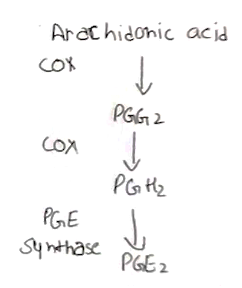Pain is an unpleasant sensory and emotional experience associated with actual or potential tissue damage.
– It is detected by nociceptors, which are thinly myelinated Ad or unmyelinated C fibres – free nerve endings
– These nociceptors have specific ion channels which respond to noxious stimuli, to initially signal pain.
–> TRPV1 activated by heat and capsaicin
–> TRPM8 activated by cold and menthol
After tissue damage, many chemicals stimuli stimulate nociceptors, including ATP (released from damaged cells) and H+ ions, released in anaerobic metabolism.
– These excite and stimulate nociceptors.
– Nociceptor activation gives peptide release leading to histamine release, vasodilation and neurogenic inflammation. This leads to localised swelling and pain.

Pain and temperature are carried by the nociceptors in the middle of the spinal cord, spinothalamic tract.
– From here there are 3 main pathways, which are responsible for experiencing different aspect of pain.
– Path to primary somatosensory cortex – responsible for discriminating pain
– Path to Anterior cingulate cortex – gives emotional element of pain
– Path to Insula – gives autonomic component of pain response
Inflammatory Pain
There are two key sensitizing agents, Prostaglandin E2 and Nerve Growth Factor (NGF):
– Prostaglandin E2 which is released by inflammatory cells, from arachidonic acid.
– This acts on nociceptors to enhance bradykinin excitation.
– It is made by the cyclooxygenase enzymes in a series of reactions (COX-1 and COX-2)
During inflammation, COX-2 becomes upregulated to increase PGE2. However, it is important to note that it is also constitutively expressed on endothelium.
– PGE2 acts on receptor EP4 –> Gs coupled –> PKA –> Phosphorylates voltage gated sodium channels reducing threshold giving more nociceptor firing
– This gives allodynia – pain sensation to stimuli which normally do not cause pain

Opioids
Within the brain, there are also descending projections from the PAG onto these neurons. These release endogenous opioids to reduce the sensation of pain:
– There are 4 opioid receptors – m, k, d and ORL. These have a bg subunit which opens K+ channels causing hyperpolarization decreasing transmitter release and also inhibits adenylyl cyclase
– This action has several inhibitory and dampening effects on the body mimicking parasympathetic stimulation, which include hypotension, urine retention, drowsiness and pupil constriction.
Hence opioid activation reduces nociceptor transmission reducing pain in 3 ways:
i) Peripherally – inhibition of adenylyl cyclase opposes sensitization from Prostaglandin E2
ii) Spinally – Hyperpolarization reduces neurotransmitter release
iii) Supraspinally – activate endogenous inhibitory systems in PAG
Neuropathic Pain
Unlike somatic pain, there is also neuropathic pain. This is a type of pain which occurs when peripheral nerve damage causes pain that outlasts the initial nerve injury. e.g. due to diabetic neuropathy, trigeminal neuralgia
– This involves changes in nociceptor processing at various levels and is managed by specialised drugs.
– These include amitriptyline, gabapentin, pregabalin and duloxetine.

